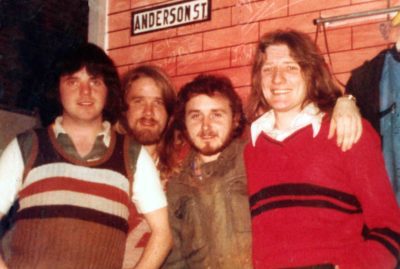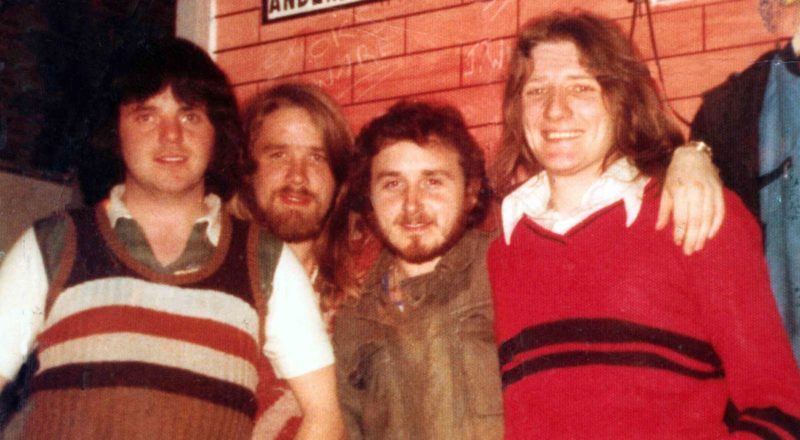INTERVIEW: Documentarian tries to find balance in telling story of Bobby Sands

Bobby Sands is a name that often elicits a strong reaction. In 1981, the 27-year-old member of the Irish Republican Army led a hunger strike at Northern Ireland’s Maze Prison. Sixty-six days later he died from his protest. His demand, shared by his fellow inmates, was to be recognized as a political prisoner.
No matter where a person falls in the Sands’s debate, there is no denying that this young man was part of a larger 20th-century story about Ireland and its relationship with the United Kingdom. Documentarian Brendan F. Byrne explores Sands’s life and contextualizes how his 66-day standoff ties into many historical themes, including the Northern Ireland “Troubles,” opposition to British rule, the influence of Margaret Thatcher and violent battles that played out in the streets.
Byrne said in a recent phone interview that he and his team strove to offer a balanced, historical perspective on the controversial figure. He admitted that Bobby Sands: 66 Days, which is currently playing the Film Forum in New York City, is a sympathetic portrait of a young man, but he wanted to have many voices represented. He also didn’t want to construct a hagiography or divisive feature.
Here’s Byrne in his own words.
On his impetus for taking on this extensive project …
“Well, in 1981, I was 15, and I was growing up in Belfast. And I was going to school at the time, and I was coming home from school in the afternoon. And I was on the bus, and out the window of the bus, the protest movement in support of Bobby Sands’s hunger strike was taking place on the school route home.
“There were thousands of people there, many of them dressed in blankets, and I knew something very seismic was happening in the country where I grew up in. But I didn’t fully understand the impact of it. I knew he was on hunger strike, but I didn’t understand where that placed him in Irish history. I didn’t understand that it was going to lead to all these things, so I was kind of in some way exposed to it. But I was also cocooned from it.
“And then when I grew up and I became a filmmaker, I kind of always remembered. It was unforgettable that summer, that kind of spring, summer, winter of 1981. It was a very dark year, but in many ways it was actually a very good summer. You kind of remember as a teenager kind of a good summer, but this was a good summer tinged with all of this kind of darkness. So when I realized this 35th anniversary of his death was coming up, and I realized it was falling within the year 2016, which was obviously a 100th anniversary of another seminal moment in Irish Republican history with the 1916 [Easter] Rising, I realized that here was a great time or the appropriate time to come and take a look at this guy. …”
“I felt as an Irishman and someone who had grown up in the middle of this time that here we have this icon, but apart from the image in the wall and what he actually did, the hunger strike, I didn’t know anymore about him. And for someone who’s interested like me and making films and interested in politics, I thought how could there be such an iconic figure, but I actually couldn’t tell you much about him. I didn’t know where he came from, didn’t know where he grew up, didn’t know what politicized him specifically. I didn’t know what motivated him to go on a hunger strike. I didn’t know how he became a leader. I didn’t know how he stepped forward in that particular time, so I thought to myself, my God, in many ways, Bobby Sands is a blank canvas.”
On the politics of his subject and the difficulty of staying balanced …
“Politically he’s a difficult figure within Ireland and Britain. … While I think the film is a sympathetic portrait of Bobby Sands, it’s careful not to be sympathetic toward the IRA. I think we lay bear the nature of the casualties of the IRA, so we’re treading some fine lines. …
“There was an opportunity of understanding and looking at it in an interesting and intelligent way, an explorative way, the 20th century and 20th-century Irish history through the lens of one guy and to put one guy at the center of it, but to realize that this guy didn’t just come out of nowhere. This guy came from a tradition that started 100 years before him. He drew on that tradition to be who he was in that moment. He was informed by that tradition. His people were shaped by that tradition.
“So if I was to do the film more in a cocoon and just look at 1981, it wouldn’t have been as rich in terms of understanding where he came from.”
On the structure of the documentary …
“We would use the 66 days of his hunger strike and sort of count down through them for, want of a better word, the contemporary thread of the film, but in spaces along the way, there was always going to be these potential stopping-off points to go back into Irish history to see where hunger strikes started, to see the connections between the British and Irish in relation to hunger strikes, through the suffragettes, to look at how sacrifice is an important element of the Republican psyche, to then look at the ramifications of Christianity and the connectedness of Christianity to Republicanism, so I knew this subject was vast.
“I was loathe to just tell a single biographical narrative, so I was always from the outset straining to try and weave all these things together in a way that kind of made it greater than the sum of its parts.”
On the difficulty of fitting this historical information into a feature-length film …
“There was a moment after Bobby Sands died on day 66. At one point we had another 40 minutes after that moment in the film because there was an awful lot more post his death that we could have gotten into. There was a big controversy about the outworkings of the rest of the hunger strike and whether or not it could have stopped earlier than it did. That’s why in the end I couldn’t go down that road because at the end of the day in an emotional level once the central character in the film dies, you’ve only got a limited time within which to wrap up the legacy of the film.
“That’s for more many reasons why I call the film Bobby Sands: 66 Days, so it’s signaling to the audience as well that we’re really framing the film within those 66 days of his life. And we weren’t going to be able to do in any great forensic nature the aftermath and the legacy years, etc., etc. I suppose once I was freed from that, and I was able to cut away that vast section after his death, then that brought us back more into the realm of 105 minutes.
“Sometimes you’re critical of your own work. Maybe I could have gotten another couple minutes out of it there. I felt that there’s only one time in a generation where you get a chance to tell this story, and I knew that this was the time. … There were things that I had to let go and some rather wonderful things I had to let go, but that’s the process of filmmaking. You just have to do it and move on, and that’s partly why you have a good team of producers and executive producers who they can spot those bits. They’re director preferences but not absolutely essential to the core narrative, so they helped me discard some of those bits.”
On using Sands’s diary entries in the film …
“I do think only the initiated are really aware of things like his diary, and his diary is not nearly republished and in the public domain as much as I think it probably should be given that it’s a unique record of an individual who was taking his own life for a cause he believed in. So it’s not as widely known as it was certainly before the film. I think the film will have engendered a certain level of additional interest in it because I think elements of Bobby Sands’s writing and some of his other prose and poetry are what distinguishes him from his many other comrades in both the IRA and the Republican movement.”
On the reception of the film around the world …
“It was a box-office hit in Ireland, which was surprising in some ways because it’s mainly regarded to be a historical subject and possibly a little bit controversial, but it’s still divisive. And not all communities in Ireland would sign up for Bobby Sands. It’s done very, very well in Ireland because it’s triggered a passion within a group of audience goers who didn’t grow up around those times, who are free from the baggage of all that history, who are hungry and voracious and interested in trying to find out [about] the country they were born into if they didn’t live through it. …
“The film’s had great reviews in the U.K. because obviously it’s in some ways Thatcher and Bobby Sands pitted as archenemies, a man vs. a woman, Britain vs. Ireland, but obviously there’s a lot of reasonable counterbalance within the film to make sure that Maggie Thatcher isn’t painted as a stereotypical figure, which is why we have her biographer and her former cabinet minister. So they see it in a more rounded context.”
By John Soltes / Publisher / John@HollywoodSoapbox.com
Bobby Sands: 66 Days is currently playing the Film Forum in New York City. Click here for more information.

